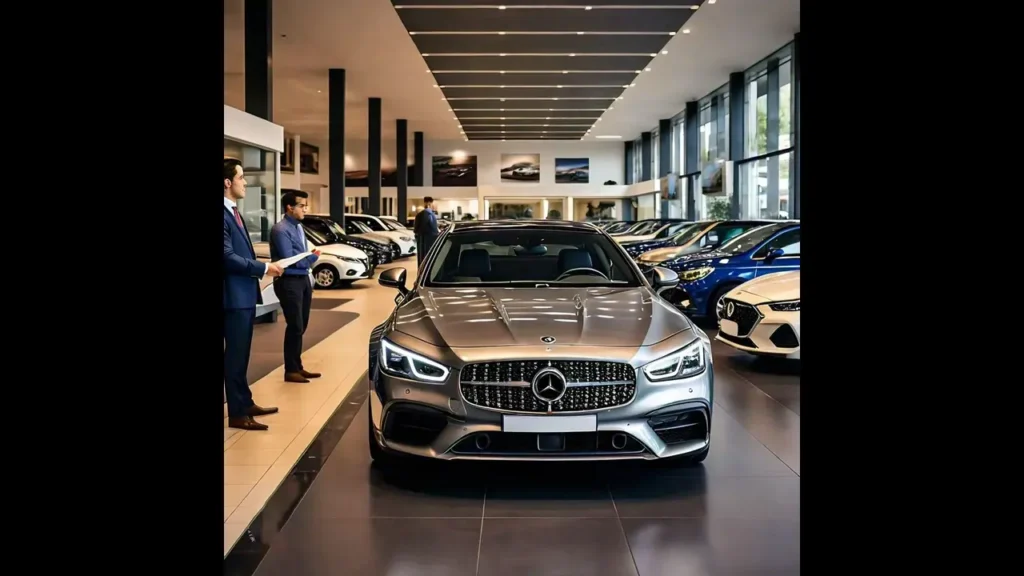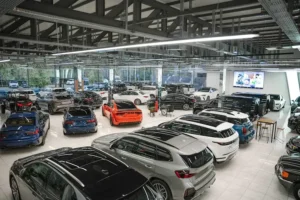Introduction
Used EV and hybrid demand in Oman is rising as charging access improves and running costs stabilize. The challenge sits in two variables that matter more than trim or paintwork: real battery health and insurable risk. Battery packs are consumable assets with measurable capacity, thermal behavior, and cell balance. Insurance products increasingly recognize those traits, pricing damage, fire, and high-voltage component exposure differently from conventional cars. A clear playbook reduces uncertainty: define the vehicle type, read the battery’s state of health, and understand how that data maps to premiums, limits, and long-term cost.
Terminology guides smarter choices. Battery electric vehicles drive only on stored energy. Plug-in hybrids pair a chargeable pack with an engine for extended range. Conventional hybrids recover braking energy and assist acceleration without wall charging. Each layout places different stress on cells, cooling systems, and power electronics. Heat is the silent risk in Gulf conditions; packs with robust thermal management age more slowly. A diagnostic session that extracts battery data from the vehicle’s management system replaces guesswork with numbers that can be attached to a contract or insurance file.
This guide builds a straight path through the complexity. First, it explains architectures and aging mechanisms so capacity loss makes sense. Second, it sets out test methods that produce credible state-of-health values rather than dashboard estimates. Third, it connects those values to insurance wording, depreciation, and price negotiations in the Omani market.
Key Takeaways / TLDR
- Battery health is the main price and risk driver in used EV and hybrid decisions.
- Vehicle type determines stress patterns: BEV, PHEV, and HEV behave differently.
- Reliable state-of-health numbers come from structured diagnostics, not guesses.
- Insurance terms increasingly reference high-voltage components and repair networks.
- Clear data supports fair pricing, warranty choices, and smoother claims.
Table of Contents
I. Understanding EV and Hybrid Used Vehicles: Core Concepts
EV and hybrid systems center on an energy store, power electronics, and thermal control. The battery pack contains modules built from cells arranged in series and parallel. A battery management system monitors voltage, temperature, and current, balancing cells to keep the pack within safe operating windows. Power flows through an inverter to the traction motor, while a DC-DC converter supplies the low-voltage network. Thermal management uses liquid or air circuits to stabilize cell temperatures; effective cooling slows degradation in hot climates.
Technology families matter. Battery electric vehicles rely entirely on the pack, so range and degradation sit at the heart of value. Plug-in hybrids carry smaller packs, cycling more frequently but at lower depth of discharge; engine support masks range loss yet adds maintenance. Conventional hybrids use compact packs with high cycle counts and rigorous cooling, trading all-electric range for durability.
Aging follows two paths. Calendar aging reduces capacity over time due to chemical side reactions, accelerating at high temperatures and high states of charge. Cycle aging stems from charge-discharge use, especially full swings, frequent high-power fast charging, or repeated deep discharges. Imbalance between modules increases internal resistance and heat, which can cascade into faster loss if not corrected by the management system.
Chemistry influences resilience. Nickel-rich cells deliver strong energy density but prefer cooler operation and moderate charge rates. Iron-phosphate cells tolerate heat and frequent cycling better, with slightly lower energy density. Buyers evaluating used stock should map chemistry, cooling design, and prior usage patterns to expected aging profiles. A vehicle that lived on DC fast chargers and sat at 100 percent state of charge in summer will present a different risk from one charged slowly and stored at mid-level. Understanding these predicates frames the diagnostic targets in the next section.
II. Battery Health Assessment for Used EV and Hybrid Buyers
A credible battery assessment produces numbers that correlate with range, performance, and repair exposure. The cornerstone metric is state of health, the ratio of usable capacity to the original nominal capacity. Accurate figures come from structured diagnostics, not generic range guesses. Begin with a battery management system scan using a tool that reads pack capacity, cycle count, module voltages, temperatures, and any imbalance or degradation flags. Record the data with timestamps and odometer reading.
Follow with targeted tests. A controlled capacity check measures energy drawn from a defined state of charge to a safe low threshold under steady load. A load step test observes voltage sag and recovery, highlighting weak modules with higher internal resistance. Thermal imaging after a standardized drive or charge session can reveal hotspots in the pack, junction boxes, or cables. Review module delta values; persistent voltage spread beyond a tight band indicates imbalance the system struggles to correct. For plug-in and conventional hybrids, prioritize hybrid battery cycle count, module pair health, and inverter temperature behavior under sustained climbs.
Interpretation needs ranges, not single cutoffs. Packs at roughly 90 percent state of health typically operate near original performance. The 80 to 85 percent band is common in mid-age vehicles and should translate into measured range reduction and a modest price adjustment. Values near 70 percent or sustained imbalance suggest budgeting for repair or module work and demanding protective clauses. Pair the health figure with usage indicators such as DC fast charge count, average state of charge history if available, and temperature logs.
Tie results to money. Quote a price corridor based on state of health, pack chemistry, and replacement cost in Oman. Ask for a battery health certificate where available and attach the diagnostic output to the sale contract. Insurance discussions should reflect the test results, confirming coverage for high-voltage components, towing for high-voltage isolation faults, and approved repair networks. Reliable diagnostics turn an opaque risk into a priced feature that supports underwriting, negotiation, and credible ownership planning.
III. Insurance Coverage for Used EV and Hybrid in Oman
Motor insurance in Oman follows familiar categories, yet electric and hybrid systems introduce component risks that shape wording and premiums. Third-party liability remains the legal baseline. Comprehensive cover adds collision, theft, fire, and natural peril protection; for electrified vehicles, strong policies also name high-voltage components such as the traction battery, inverter, on-board charger, DC-DC converter, electric motor, and high-voltage wiring. The best policies treat the traction battery as an insured part with clear limits rather than a vague exclusion.
Premium formation reflects several inputs: vehicle value, battery replacement cost, availability of approved repair networks, parts lead times, and historical loss data for that model. Hybrids with smaller packs often price below full battery electric vehicles because replacement exposure is lower; however, complex power electronics can offset that gap. Underwriting may apply sub-limits for high-voltage components, a separate excess for battery claims, or depreciation tables that differ from body panels.
Exclusions require close reading. Degradation from normal aging is typically not an insurable event. Improper charging, non-approved modifications, or water ingress through misuse can be excluded. Some policies add conditions around home charging, such as certified wallbox installation and compliant breakers. Towing and storage protocols matter for safety; look for cover that includes isolation procedures, EV-ready recovery trucks, and transport to an authorized center.
Claims handling should specify diagnostics by trained technicians, use of model-specific tools, and availability of genuine parts. Repair pathways differ from conventional vehicles; an isolation fault, inverter failure, or battery thermal event follows technical decision trees that insurers and workshops must recognize. A clear endorsement can list covered high-voltage items, testing standards before parts replacement, and environmental handling for damaged modules.
For resale and lender comfort, documented insurance with explicit high-voltage terms signals managed risk. Policies that align coverage with measured battery state of health, verified charging installations, and named EV repair partners create predictable outcomes, which is exactly what the used market values when pricing electrified stock in Oman.

IV. Purchase Strategy and Risk Mitigation for Used EV or Hybrid
A disciplined purchase plan ties diagnostics to money flows and future protection. Contracts should reference a battery state of health threshold, the diagnostic method used, and the date of testing. A hold-back or escrow amount linked to post-purchase verification reduces exposure; funds release once the vehicle passes a standardized health check and no isolation faults or thermal anomalies are found. Where available, a third-party battery health certificate can be appended as a condition precedent.
Warranty architecture deserves structure. If manufacturer battery coverage remains, transferability and remaining years or kilometers should appear in the agreement. If not, an aftermarket or dealer warranty that specifically names high-voltage components, approved repairers, and claim timelines can be added. Terms that exclude degradation while covering sudden failure reflect typical practice and should be understood before pricing discussions close.
Spares readiness and service access influence total cost. Availability of modules, inverters, or on-board chargers within Oman or through authorized import channels reduces downtime and rental costs during claims. For plug-in models, charger compatibility with local grid conditions, connector type, and software version support should be verified. Home charging readiness requires a compliant wallbox, appropriate breaker capacity, and surge protection; insurers may request proof of installation when underwriting.
Charging infrastructure density shapes operating convenience rather than pure risk. A map of public DC fast chargers, site uptime patterns, and payment methods helps set expectations for daily use. Frequent fast charging, high average state of charge, or sustained high-temperature parking shortens battery life; contract disclosures that include fast charge counts from logs can support fair pricing.
Price should track measured risk. A simple matrix links state of health bands to discount corridors, adjusted for chemistry, cooling design, and warranty tail. Financing partners often prefer documented diagnostics and clear insurance endorsements, which can lower total borrowing cost. By aligning test data, contract protections, warranty scope, and insurance wording, the transaction converts uncertainty into a portfolio of controls that the Omani market recognizes and rewards.
V. Residual Value and Depreciation Modeling
Residual value for electrified vehicles pivots on battery condition, chemistry, and support infrastructure. A practical model breaks price into three layers: base vehicle value excluding the traction battery, traction battery value indexed to measured state of health, and market liquidity factors such as warranty tail and repair network maturity. This decomposition avoids blunt discounts and ties numbers to verifiable attributes.
State of health acts as the primary multiplier. Packs at roughly 90 percent often trade close to conventional curves for the same age and mileage. The 80 to 85 percent band introduces a moderate discount that reflects shorter usable range and higher probability of module work during the next ownership window. At or below 75 percent, buyers typically seek either a price set aside for repair or a warranty commitment that shares risk. Chemistry matters: iron-phosphate cells generally retain capacity differently from nickel-rich cells in heat; depreciation slopes should reflect those profiles.
Warranty remaining years or kilometers shift the curve. A significant battery warranty tail compresses risk and supports tighter bid-ask spreads; expired coverage widens spreads, especially for models with costly packs or scarce modules. Repair network strength also affects value. Units with local parts pipelines and trained technicians command firmer prices than orphaned imports with long lead times.
Scenario modeling clarifies decisions. A good-health case assumes state of health near 90 percent, warranty tail of two years, and verified slow-charge history; depreciation follows a gentle curve. A mid case at 82 percent with limited warranty support uses a steeper line and includes a budget for cooling system service. A degraded case at 70 to 75 percent loads a contingency for module balancing or replacement, and the model tests resale viability after planned repairs.
Transparent inputs build trust. Publishing the diagnostic printout, warranty status, and any price adjustment formula tied to state of health creates a market standard. As more transactions adopt this structure, Oman’s used EV and hybrid pricing converges on observable battery metrics rather than narratives, which improves liquidity and aligns valuations with real risk.
VI. Comparative Benchmarking and Regional Cases
Regional practice offers signals that can be adapted to Oman’s used EV and hybrid market. In the UAE, large franchised dealers lean on certified programs that publish battery inspection summaries, module balance data, and warranty tails. Listings often reference service campaigns and software updates that affect thermal management or charging profiles. This transparency narrows bid–ask spreads and shortens time to sale. Saudi dealers increasingly add state-of-health summaries and price batteries as distinct assets in appraisal sheets, which clarifies depreciation math and helps lenders set residual assumptions.
Insurance handling in the Gulf is converging on a pattern. Third-party liability remains standard; comprehensive cover names high-voltage components, isolation procedures, and approved repairers. Sub-limits and separate excesses for traction batteries are common, coupled with requirements for certified home charging. Markets with broader repair networks show faster claim cycles and fewer total-loss outcomes for faults that are repairable with modules and software rather than full pack swaps.
Battery certification is the differentiator abroad. European used-EV channels popularized third-party battery health certificates that include measured usable capacity, internal resistance trends, temperature behavior, and imbalance metrics. Where certificate providers partner with marketplaces, vehicles with a verified report sell faster and with fewer returns. The approach translates well to hot-weather markets when temperature stress tests are baked into the protocol and cooling performance is documented alongside capacity.
Parts logistics and training determine real-world uptime. GCC markets with central parts depots for modules, inverters, and on-board chargers display shorter cycle times from diagnosis to fix. Where supply chains lag, dealers resort to goodwill swaps or extended courtesy cars, which raises cost and volatility. Oman can borrow the logistics blueprint: designate EV-trained centers, publish parts lead-time targets, and standardize diagnostic trees for high-voltage faults.
The lesson is direct. Pair transparent diagnostics with insurance language that names components and repair pathways. Publish state-of-health bands in price guides. Incentivize dealers to adopt certificate-grade testing and to disclose fast-charge counts, thermal events, and software status. These steps raise trust, stabilize valuation, and keep electrified stock liquid in Oman’s used market.
VII. Buyer Checklist for Used EV and Hybrid in Oman
Preparation turns a complex purchase into a predictable transaction. Start with identity and provenance. Match VIN on the chassis, windshield, and documents. Decode VIN for chemistry, cooling design, and market specification. Confirm recalls and software updates are complete, especially items tied to thermal control or charging reliability.
Run structured diagnostics. Read battery management system data for usable capacity, cycle count, module voltage spread, temperatures, and high-voltage fault history. Capture a capacity estimate through a controlled discharge or an accepted certificate method. Add a load step test to reveal weak modules, and use thermal imaging after a standard drive to detect hotspots in the pack or inverter.
Evaluate usage patterns. Note DC fast-charge counts, average state of charge, and storage habits where logs exist. Cross-check with service history for cooling system service, desiccant replacement, or inverter repairs. For plug-in and conventional hybrids, review hybrid battery pair health and inverter temperatures under sustained load.
Structure the contract. Attach the diagnostic printout and any battery certificate. Insert a state-of-health threshold, isolation-fault clause, and hold-back tied to a post-purchase health check. Record odometer reading, charger type provided, and any home-charging compliance requirements. If manufacturer battery coverage remains, confirm transferability in writing.
Align insurance and operations. Select comprehensive cover that names traction battery, inverter, on-board charger, and high-voltage wiring. Check sub-limits, excesses, towing protocols, and approved centers. For home charging, keep the wallbox installation certificate and breaker rating on file. Map daily routes to available public chargers and note site uptime patterns.
Close with price logic. Apply a discount corridor tied to state of health, chemistry, cooling design, and warranty tail. Budget for known maintenance items and potential module work if imbalance persists. A file containing diagnostics, contract addenda, insurance endorsement, and charger compliance turns future claims and resale into process steps rather than arguments.
IX. Oman Charging and Service Infrastructure Landscape
Charging access and repair capacity shape real ownership cost more than headline range figures. Oman’s public network continues to expand along highways, malls, hotels, and mixed-use districts, with 22–50 kW DC fast chargers forming the backbone and higher-power units appearing at flagship sites. Home charging remains the anchor for daily use; a wallbox on a dedicated breaker with surge protection delivers predictable overnight replenishment and healthier battery profiles than constant fast charging. Workplace chargers add resilience for commuters and reduce weekend queue pressure at public stations.
Connector standards matter at purchase. Model-specific plug types and charging curves determine where a vehicle can charge at rated speeds. A compatibility check should confirm plug type, maximum AC onboard charger capacity, and DC peak rate; the operational question is not only maximum kW but how long the car sustains that rate before taper. For hybrids, AC charging speed sets convenience; for full EVs, DC profile and thermal stability decide road-trip cadence. Software currency also influences charging reliability, as updates can fix handshake issues and improve pre-conditioning.
Service infrastructure is maturing. EV-trained technicians, high-voltage isolation tools, and insulated bays are concentrating at authorized centers; independent workshops are adding diagnostics for inverters, on-board chargers, and battery junction boxes. Parts pipelines for modules, coolant plates, and contactors remain uneven by brand; buyers should ask about lead times and whether modules can be replaced at sub-pack level. For hybrids, availability of battery pair modules, MG1/MG2 motor components, and power electronics cooling parts is the key uptime variable.
Operational habits extend component life. Frequent partial charges, shaded parking, cabin pre-cooling while plugged in, and periodic coolant service reduce thermal stress. Logging charge sessions and temperatures helps correlate behavior with any future warranty or insurance claim. When buyers match a vehicle’s charging and service realities with personal routes and parking conditions, the daily experience becomes predictable, and residual value benefits from documented, battery-friendly usage.
X. FAQ: Used EV and Hybrid Buyers in Oman
What is a healthy state of health for a used battery pack?
Packs around 90 percent state of health typically drive close to original performance. The 80–85 percent band is common at mid-age and should prompt a modest discount. Near 70–75 percent, pricing should reflect likely module work or tighter warranty terms.
Does insurance cover battery degradation?
Normal capacity loss is treated as wear and is usually excluded. Comprehensive policies should still name high-voltage components for sudden damage, isolation faults, thermal events, and collision-related replacement, with clear sub-limits and excesses.
How do DC fast-charge counts affect pricing?
Frequent fast charging raises thermal and cycle stress. High counts, especially in hot months, justify stronger discounts unless the model uses heat-tolerant chemistry and robust liquid cooling. Pair fast-charge data with state-of-health readings for fair valuation.
Can a third-party battery certificate be required in a transaction?
Yes. Many markets accept independent certificates that report usable capacity, imbalance, and thermal behavior. In Oman, attaching such a certificate to the sale contract improves lender comfort and simplifies future resale.
What hybrid-specific checks matter most?
Cycle count and module balance, inverter temperature under sustained load, cooling system health, DC-DC converter output stability, and engine-to-motor handoff smoothness. A lift inspection for exhaust heat-shield proximity to hybrid cables is also prudent.
XI. Conclusion and Actionable Next Steps
A reliable used EV or hybrid purchase in Oman aligns four elements: verified battery health, suitable insurance coverage, workable charging access, and a repair network with known lead times. Battery condition anchors the price; insurance transfers sudden-failure risk into predictable costs; infrastructure determines daily convenience; service capacity decides downtime. When these pieces are documented, the market treats electrified vehicles as measurable assets rather than experiments.
A practical route begins with structured diagnostics that read battery management data, run a load step, and record thermal behavior. Attach the printout or third-party certificate to the contract, set a state-of-health threshold, and include a hold-back pending a quick post-purchase check. Select comprehensive insurance that names the traction battery, inverter, on-board charger, high-voltage wiring, towing protocols, and approved centers. Confirm home-charging compliance with an installation certificate and breaker rating.
Next, map daily routes to public charging and note uptime patterns at preferred sites. For hybrids, validate power electronics cooling, inverter temperatures, and module balance under sustained climbs typical of local terrain. Ask dealers about parts pipelines and typical turnaround times for high-voltage components. Finally, price with a clear matrix that links state of health, chemistry, cooling design, and warranty tail to discount corridors. This blend of diagnostics, paperwork, and infrastructure matching turns uncertainty into a documented plan that lenders, insurers, and future buyers understand—keeping ownership costs predictable and resale timelines short in Oman’s growing electrified market.











